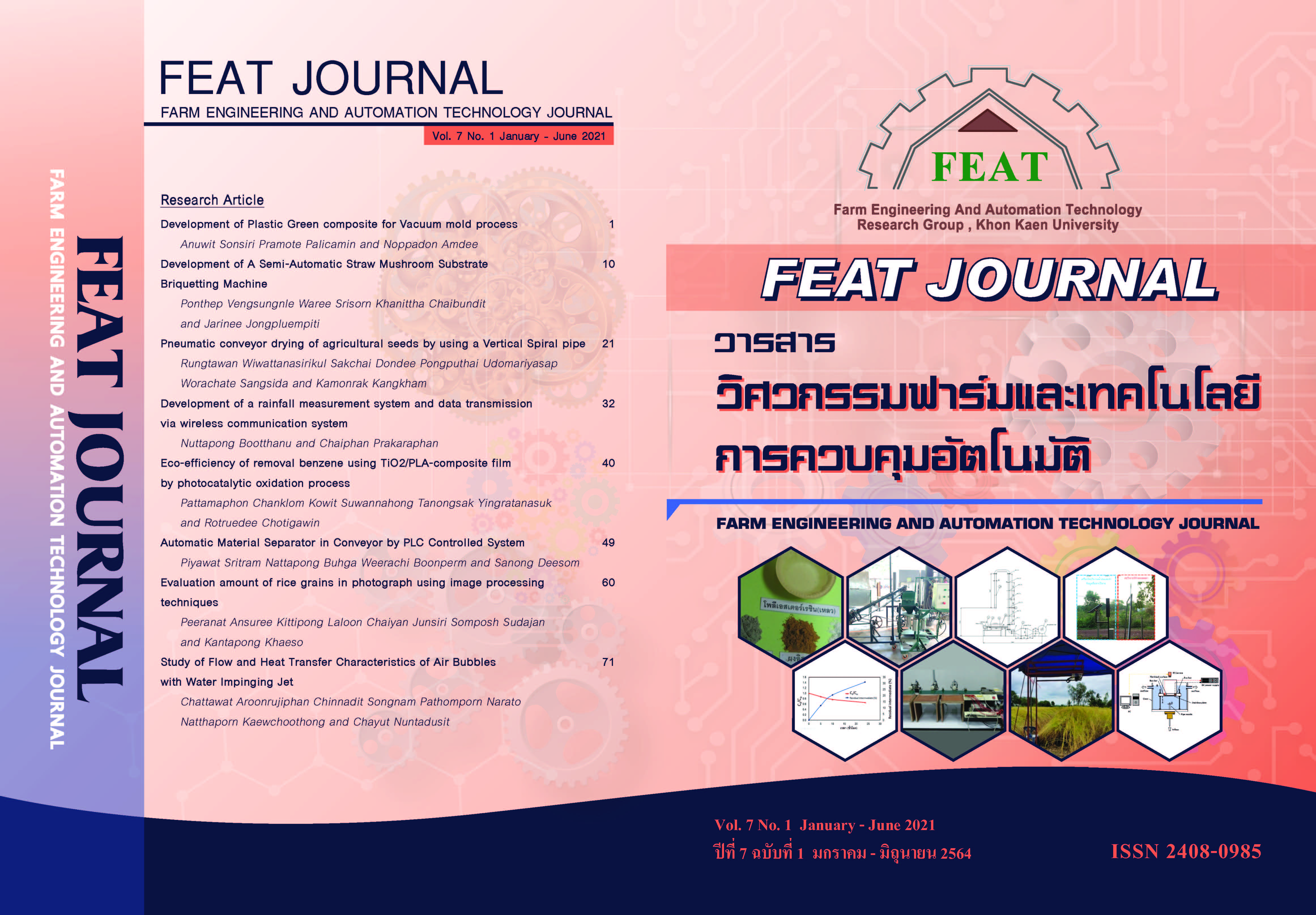การอบแห้งเม็ดวัสดุทางการเกษตรขณะขนถ่ายด้วยลมร้อนในท่อเกลียวแนวตั้ง
Main Article Content
บทคัดย่อ
การวิจัยครั้งนี้มีวัตถุประสงค์เพื่อทดสอบและศึกษาตัวแปร ได้แก่ ความเร็วของอากาศร้อน อัตราการป้อนวัสดุ อุณหภูมิอบแห้ง และความดันสูญเสียในท่ออบแห้ง ที่มีอิทธิพลต่อการเปลี่ยนแปลงความชื้นของการอบแห้ง ข้าวเปลือก มันสำปะหลังที่มีลักษณะเป็นเม็ดเล็ก ข้าวโพด เมล็ดถั่วลิสง ด้วยเครื่องอบแห้งขณะที่มีการขนถ่ายวัสดุในท่อเกลียวแนวตั้ง ร่วมกับพลังงานความร้อนจากขดลวดความร้อน โดยใช้ลมเป็นพาหะ รวมถึงการใช้พลังงานของการอบแห้งของผลผลิตทางการเกษตรดังกล่าว จากการศึกษาพบว่า ที่ค่าความเชื่อมั่น 95 % ความดันสูญเสียรวมของการไหลของวัสดุในท่อเกลียวแนวตั้งทั้ง 4 ชนิด มีแนวโน้มเพิ่มขึ้น เมื่อความเร็วของลมมีค่าเพิ่มขึ้น นอกจากนี้ที่ความเร็วของลมมีค่าคงที่เท่ากันที่อัตราการป้อนวัสดุเพิ่มขึ้นจะมีความดันสูญเสียเพิ่มขึ้น ที่อัตราการป้อนวัสดุคงที่ อุณหภูมิอบแห้งมีค่าเพิ่มขึ้น ทำให้การเปลี่ยนแปลงความชื้นมีแนวโน้มเพิ่มขึ้นเหมือนกันของวัสดุทั้ง 4 ชนิด จากการศึกษาที่อัตราการป้อนวัสดุต่ำสุดเท่ากับ 0.03 kg/s อุณหภูมิการอบแห้งเท่ากับ 90 ๐C ความเร็วลมเท่ากับ 20 m/s การเปลี่ยนแปลงความชื้นมีค่ามากที่สุดเท่ากับ 7.73 % (w.b) และการใช้พลังสำหรับการอบแห้งมีค่าเท่ากับ 4.09 MJ/kgwater สำหรับข้าวเปลือก และมันสำปะหลัง มีค่าเท่ากับ 13.16 % (w.b) และเท่ากับ 1.39 MJ/kgwater สำหรับข้าวโพดและถั่วลิสง ที่อัตราการขนถ่ายวัสดุต่ำสุดเท่ากับ 0.03 kg/s อุณหภูมิอบแห้งสูงสุดเท่ากับ 70 ๐C ความเร็วลมเท่ากับ 20 m/s มีการเปลี่ยนแปลงความชื้นสูงสุดเท่ากับ 2.64 % (มาตรฐานเปียก) และ 2.04 % (w.b) และการใช้พลังงานของการอบแห้งต่ำสุด เท่ากับ 6.94 MJ/kgwater และ 8.99 MJ/kgwater ตามลำดับ นอกจากนี้ยังพบว่าเมื่อวัสดุทั้ง 4 ชนิดอยู่ในระบบนาน จะทำให้วัสดุมีการแตกหักมากขึ้น
Article Details
วารสารวิศวกรรมฟาร์มและเทคโนโลยีควบคุมอัตโนมัติ (FEAT Journal) มีกําหนดออกเป็นราย 6 เดือน คือ มกราคม - มิถุนายน และ กรกฎาคม - ธันวาคม ของทุกปี จัดพิมพ์โดยกลุ่มวิจัยวิศวกรรมฟาร์มและเทคโนโลยีควบคุมอัตโนมัติ คณะวิศวกรรมศาสตร์มหาวิทยาลัยขอนแก่น เพื่อเป็นการส่งเสริมและเผยแพร่ความรู้ ผลงานทางวิชาการ งานวิจัยทางด้านวิศวกรรมศาสตร์และเทคโนโลยีพร้อมทั้งยังจัดส่ง เผยแพร่ตามสถาบันการศึกษาต่างๆ ในประเทศด้วย บทความที่ตีพิมพ์ลงในวารสาร FEAT ทุกบทความนั้นจะต้องผ่านความเห็นชอบจากผู้ทรงคุณวุฒิในสาขาที่เกี่ยวข้องและสงวนสิทธิ์ ตาม พ.ร.บ. ลิขสิทธิ์ พ.ศ. 2535
เอกสารอ้างอิง
Guner M. Pneumatic conveying characteristics of some agricultural seeds. Food Engineering. 2007; 80(3): 904-13.
พรชัย จงจิตรไพศาล. ระบบขนถ่ายวัสดุด้วยลม.สำนักพิมพ์ส่งเสริมเทคโนโลยี: กรุงเทพฯ; 2548.
Lalit RV, Chung MT. Pneumatic conveying of grains. Louisiana state University. Journal for Hawaiian and Pacific Agriculture. 1993; 4: 1-13.
Brooker DB, Bakker-Arkema FW, Hall CW. Drying and Storage of Grains and Oilseeds. AVI Book Publishing: New York; 1992.
Arun S Mujumdar.Drying Technology in Agriculture and Food Sciences.Science Publishers Inc. New Hampshire: United States of America; 2000.
Bunyawanichakul P, Walker GJ, Sargison JE, Doe PE. Modelling and Simulation of Paddy Grain (Rice) Drying in a Simple Pneumatic Dryer. Biosystems Engineering. 2007; 96(3): 335–44.
Tanaka F, Uchino T, Hamanaka D, Atungulu GG. Mathematical modeling of pneumatic drying of rice powder. Journal of Food Engineering. 2008; 88(4): 492–8.
Rajan KS, Srivastava SN, Pitchumani B, Mohanty B. Simulation of gas–solid heat transfer during pneumatic conveying. Use of multiple gas inlets along the duct. International Communications in Heat and Mass Transfer. 2006; 33(10): 1234–42.
Rajan KS, Srivastava SN, Pitchuman B, Dhasandhan K. Experimental study of thermal effectiveness in pneumatic conveying heat exchanger. Applied Thermal Engineering. 2008; 28(14-15): 1932–41.
Rajan KS, Dhasandhan K, Srivastava SN, Pitchumani B. Studies on gas–solid heat transfer during pneumatic conveying. International Journal of Heat and Mass Transfer. 2008; 51 (11-12): 2801–13.
Zheng Y, Pugh JR, McGlinchey D, Ansell RO. Simulation and experimental study of gas-to- particle heat transfer for non-invasive mass flow measurement. Measurement. 2008; 41(4): 446–54.
ZHOU JS, LUO ZY, Xiang GAO, NI MJ and Cen KF. Effect of particle loading on heat transfer enhancement in a gas-solid suspension cross flow. Journal of Zhejiang University Science. 2002; 3(4): 381–6.
Hidayat M, Rasmuson A. Heat and mass transfer in u-bend of a pneumatic conveying dryer. Chemical Engineering Research and Design. 2007; 85(A3): 307–19.
Rabinovich E, Kalman H. Flow regime diagram for vertical pneumatic conveying and fluidized bed systems. Powder Technology. 2011; 207(1-3): 119–33.


